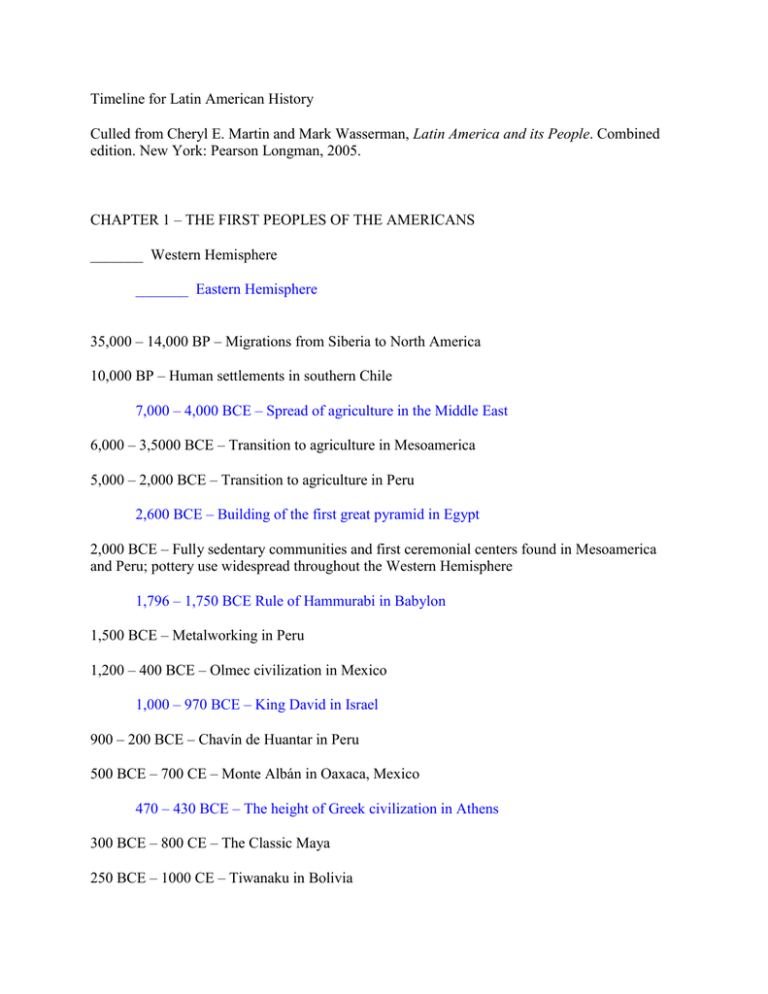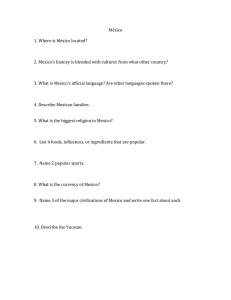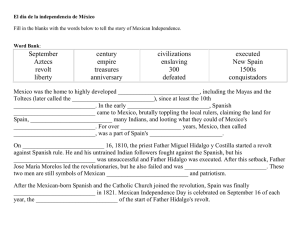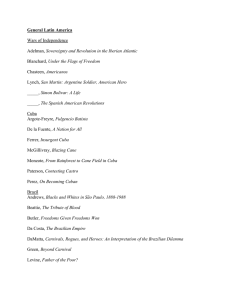
Timeline for Latin American History
Culled from Cheryl E. Martin and Mark Wasserman, Latin America and its People. Combined
edition. New York: Pearson Longman, 2005.
CHAPTER 1 – THE FIRST PEOPLES OF THE AMERICANS
_______ Western Hemisphere
_______ Eastern Hemisphere
35,000 – 14,000 BP – Migrations from Siberia to North America
10,000 BP – Human settlements in southern Chile
7,000 – 4,000 BCE – Spread of agriculture in the Middle East
6,000 – 3,5000 BCE – Transition to agriculture in Mesoamerica
5,000 – 2,000 BCE – Transition to agriculture in Peru
2,600 BCE – Building of the first great pyramid in Egypt
2,000 BCE – Fully sedentary communities and first ceremonial centers found in Mesoamerica
and Peru; pottery use widespread throughout the Western Hemisphere
1,796 – 1,750 BCE Rule of Hammurabi in Babylon
1,500 BCE – Metalworking in Peru
1,200 – 400 BCE – Olmec civilization in Mexico
1,000 – 970 BCE – King David in Israel
900 – 200 BCE – Chavín de Huantar in Peru
500 BCE – 700 CE – Monte Albán in Oaxaca, Mexico
470 – 430 BCE – The height of Greek civilization in Athens
300 BCE – 800 CE – The Classic Maya
250 BCE – 1000 CE – Tiwanaku in Bolivia
100 BCE – 750 CE – Teotihuacan, Mexico
27 BCE – Augustus founds the Roman Empire
100 – 750 CE – The Moche and Nazca in coastal Peru
476 CE – The fall of Rome
500 – 850 CE – The Wari Empire, Peru
700 – 800 CE – Spread of Islam
700 – 1200 CE – Mixtec ascendancy, Oaxaca, Mexico
800 – 1517 CE - The Post-Classic Maya
900 – 1200 CE – The Toltecs, central Mexico
1066 CE – Norman Conquest of England
1150 – 1532 CE – The Chimu Kingdom, Peru
CHAPTER 2 – AMERICANS AND IBERIANS ON THE EVE OF CONTACT
700 – 800 – Muslims take over much of Spain and Portugal
c. 1200 – Collapse of Tiwanaku in the Andes
1249 – 1250 – Christian Reconquista of Portugal and most of Spain
c. 1300 – Mexica arrive in the Valley of Mexico and
Late 1340s – Black Death in Spain and Portugal
1370s – Mexica ruling dynasty established
1385 – 1433 – King João I establishes Aviz dynasty political independence of Portugal
1415 – Portuguese take Ceuta in North Africa
1418 – 1472 – Rule of Nezahualcoyotl in Texcoco
1428 – Triple Alliance defeats Azcapotzalco and gains control of the Valley of Mexico
1438 – 1471 – Rule of Pachacuti Inca Yupanqui
1440 – 1468 – Rule of Moctezuma I in Tenochtitlan
1450s – Droughts and food shortages in central Mexico
1469 – Marriage of Isabella of Castile and Ferdinand of Aragón
1478 – Spanish Inquisition established
1487 – Dedication of new temple of Huitzilopochtli in Tenochtitlan
1492 – Voyage of Columbus; defeat of Granada
1492 – 1497 – Expulsion and force conversions of Spanish and Portuguese Jews
1493 – 1525 – Rule of Huayna Capac
1498 – Portuguese navigator Vasco da Gama reaches India
1502 – Expulsion of Muslims from Spain
1516 – Charles I becomes first monarch of a united Spain
CHAPTER 3 – THE EUROPEAN CONQUEST OF AMERICA
1492 – Columbus’s first voyage
1500 – Cabral’s expedition lands in Brazil
1502 – Nicolás de Ovando arrives as governor of Hispaniola, with 2500 colonists
1508-1511 – Spanish settlement of Puerto Rico, Jamaica, and Cuba
1516 – Charles I becomes first monarch of a united Spain
1518 – First recorded outbreak of smallpox in the Americas; first direct slave imports from
Africa to Spanish America
1519-1521 – Conquest of Mexico
1532 – Pizarro and Atahualpa meet
1536 – Revolt of Manco Inca
1537 – 1548 – Civil wars in Peru
1539 – 1542 – Expeditions of Francisco Vásquez de Coronado and Hernando de Soto
1542 – 1543 – New Laws issued in an attempt to curb abuses of natives in Spanish America
1549 – Tomé Sousa arrives as governor of Brazil
1556 – Philip I becomes king of Spain
1559 – 1562 – Smallpox epidemics in coastal Brazil
1560s – Taqui Onkoy rebellion in Peru
1572 – Defeat of the neo-Inca state at Vicabamba in Peru
1580 – Philip II of Spain becomes king of Portugal
1607 – 1608 – Permanent English and French colonization of North America begins
1610s – Portuguese authorities defeat santidade movement in Brazil
1630 – 1654 – Dutch control of northeastern Brazil
1640 – Portugal declares independence from Spain
CHAPTER 4 – THE IBERIAN’S NEW WORLD
1540s – Silver found at Zacatecas, Mexico, and Potosí, Bolivia. The repartimiento (forced labor
draft) established in Mexico
1560s – Epidemics devastate Indian population in Brazil, sugar planters begin relying more on
African slave labor
1563 – 1700 – Building of the Mexico City cathedral
1570s – Viceroy Toledo begins the mita to supply workers for silver mines in Peru
1580 – Brazil the world’s leading producer of sugar
1628 – Dutch pirates seize Mexican silver fleet at Matanzas Bay in Cuba
1650s – Brazilian sugar industry begins to decline
1655 – The British seize Jamaica from the Spanish
1670 – Treaty of Madrid. The Spanish formally cede Jamaica to the British
1690s – First gold discoveries in the interior of Brazil
1697 – The Spanish cede west part of Hispaniola to the French
CHAPTER 5 – THE AMERINDIANS’ CHANGING WORLD
1549 – First Jesuits arrive in Brazil
1568 – 1572 – Jesuits arrive in Peru and Mexico
1570s – Viceroy Toledo orders massive relocation of Peru’s Indian population
1573 – Franciscan missionaries begin work in Florida
1591 – Founding of San Estaban de la Nueva Tlaxcala
1598 – Franciscans begin work among the Pueblo of New Mexico
1610 – Jesuit missionaries begin work among the Guaraní in Paraguay
1615 – Felipe Guaman Poma de Ayala completes his history of Peru
1680 – Pueblo rebellion in New Mexico
1690s – Jesuit missionaries active in Sonora and southern Arizona
1692 – Rebellion of Indians and other lower classes in Mexico City; Spaniards begin reconquest
of New Mexico
1712 – Indian rebellion in Chiapas
1769 – Franciscans begin building missions in California
CHAPTER 6 – A NEW PEOPLE AND THEIR WORLD
1570s – Establishment of Inquisition tribunals in Mexico City and Lima
1650 – Importation of African slaves declines in much of Spanish America
1677 – First convent in Brazil established
1683 – Black militia forces help repel pirate attack on Veracruz
1692 – Uprising of lower classes in Mexico City
1724 – Founding of a convent for Indian women in Mexico
1735 – Slave revolt in the Córdoba, Veracruz, region of Mexico
CHAPTER 7 – THE SHIFTING FORTUNES OF COLONIAL EMPIRES
1700 – Death of King Charles II of Spain, accession of Philip V and beginning of the
Bourbon dynasty
1700 – 1713 – War of the Spanish Succession
1703 – Commercial treaty between England and Portugal
1718 – Founding of San Antonio, Texas
1739 – Creation of the viceroyalty of New Granada
1739 – 1748 – War of Jenkins’ Ear, War of the Austrian Succession
1740 – Spain begins abandonment of fleet system
1756 – 1763 – Seven Years’ War
1759 – Expulsion of Jesuits from Brazil
1762 – 1763 – British occupation of Havana
1763 – Treaty of Paris: France surrenders North American possessions; Spain gets Louisiana,
England gets Florida
1767 – Expulsion of the Jesuits from Spanish America
1776 – Separate military command created for northern frontier of New Spain; creation of
viceroyalty of Río de la Plata
1776 – 1783 – American Revolution
1780 – 1781 – Revolt of Tupac Amaru II; Comunero revolt in New Granada
1788 – 1789 – Conspiracy in Minas Gerais, Brazil
1789 – Beginning of the French Revolution
1791 – Haitian Revolution begins
1797 – Spain surrenders Trinidad and the West Indies to the British
1798 – Conspiracy in Bahia (Salvador) in northeastern Brazil
1803 – United States acquires Lousiana
1815 – Defeat of Napoleon
1819 – Spain cedes Florida to the United States
CHAPTER 8 – THE NEW NATIONS OF LATIN AMERICA
1783 – United States wins its independence
1788 – Charles IV takes the throne of Spain
1789 – French Revolution
1791 – Haitian Revolution
1807 – 1808 – Napoleon’s armies invade Portugal and Spain
1810 – Hidalgo begins Mexican War of Independence
1812 – New Spanish Constitution
1821 – Mexican independence
1822 – Brazilian independence
1824 – Battle of Ayacucho ends wars of independence
CHAPTER 9 – REGIONALISM, WAR, AND RECONSTRUCTION: POLITICS AND
ECONOMICS, 1821 – 1880
1814-1840 – Dr. Francia rules Paraguay
1822 – 1831 – Pedro I rules in Brazil
1829 – Gran Colombia breaks up
1829 – 1852 – Juan Manuel de las Rosas dominates the Río de la Plata
1835 – 1836 – Texas War of Secession against Mexico
1836 – 1838 – Peru-Bolivia Confederation
1846 – 1848 – U.S. war against Mexico
1857 – 1860 – War of the Reforma in Mexico
1879 – 1883 – War of the Pacific (Chile v. Peru and Bolivia)
1862 – Argentine unification
1862 – 1867 – French occupation of Mexico
1865 – 1870 – Paraguayan War or War of the Triple Alliance
CHAPTER 11 – ECONOMIC MODERNIZATION, SOCIETY, AND POLITICS, 1880 – 1920
1876 – Porfirio Díaz takes power inMexico
1888 – Aboliton of slavery in Brazil
1889 – Empire overthrown by military in Brazil
1891 – Chilean civil war ousts President José Manuel Balmaceda; parliamentary rule begins
1910 – Mexican Revolution begins
1912 – Sáenz Peña Law in Argentina extends male suffrage
1912 – Foreign investment in Latin America reaches $US 8.5 billion
1916 – Election of Hipólito Yrigoyen as president of Argentina
1917 – Mexican Constitution
1919 – Semana Trágica in Buenos Aires
CHAPTER 12 – BETWEEN REVOLUTIONS: THE NEW POLITICS OF IMPORT
SUBSTITUTION INDUSTRIALIZATION, 1920 – 1959
1914 – 1918 – World War I
1919 – 1930 – Augusto B. Leguía dictator of Peru
1924 – Young military officers overthrow President Arturo Alessandri in Chile
1921 – 1941 – Great Depression
1933 – Cuban Revolution ousts dictator Gerardo Machado
1937 – Getúlio Vargas overturns his own government and establishes the Estado Novo
1938 – Lázaro Cárdenas expropriates foreign oil companies in Mexico
1939 – 1945 – World War II
1946 – Juan Domingo Perón elected president of Argentina
1956 – Fulgencio Batista returns to Cuba as dictator
CHAPTER 14 – REVOLUTION, REACTION, DEMOCRACY, AND THE NEW GLOBAL
ECONOMY: 1959 TO THE PRESENT
1959 – Cuban Revolution
1961 – Unites States establishes the Alliance for Progress
1964 – Brazilian military overthrows João Gulart
1968 – Peruvian Revolution; Juan Velasco Alvarado
1970 – Dr. Salvador Allende elected in Chile
1973 – Allende ousted by Chilean army
1974 – Juan Domingo Perón returns to Argentina
1979 – Sandinista Revolution in Nicaragua
1982 – Malvinas/Flaklands War (Argentina v. United Kigdom)
1990 – Alberto Fujimori elected president of Peru






